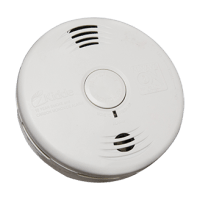Ionization smoke alarms are more responsive to flaming fires
In an ionization smoke alarm, a small amount of radioactive material between two electrically charged plates ionizes the air, causing a current to flow between the plates. When smoke enters the chamber, it interrupts the flow of ions, which reduces the flow of the current and triggers the alarm.
These alarms should not be placed near kitchens or bathrooms, as heat and steam can cause them to sound.
Photoelectric smoke alarms are more responsive to smoldering fires
In a photoelectric smoke alarm, a light is aimed into a sensing chamber but away from the sensor itself. When smoke enters the chamber, it causes the light to be reflected onto the sensor, activating the alarm.
What type of smoke alarm should you get?
Because photoelectric and ionization alarms are most effective against different types of fires, the best protection will come from having both in your home. Kidde also offers dual-sensor smoke alarms that contain both ionization and photoelectric sensors in one device.





